|
|
 |
|
Calanoida ( Order ) |
|
|
|
Clausocalanoidea ( Superfamily ) |
|
|
|
Scolecitrichidae ( Family ) |
|
|
|
Scolecithricella ( Genus ) |
|
|
| |
Scolecithricella abyssalis (Giesbrecht, 1888) (F, M) | |
| | | | | | | Syn.: | Scolecithrix abyssalis Giesbrecht, 1888; 1892 (p.266, 284, 775, figs.F); Giesbrecht & Schmeil, 1898 (p.43, Rem. F,M); Wolfenden, 1911 (p.250); Sars, 1925 (p.189, figs.F);
Scolecithrix dubia (M) : Giesbrecht, 1892 (p.266, figs.M); Tanaka, 1937 (p.260, figs.M);
? Scolecithrix profunda Giesbrecht, 1892 (p.266);
Scolecithrix tumida T. Scott, 1894 b (p.52, figs.F); Sewell, 1948 (p.523);
no Scolecithricella abyssalis : Tanaka, 1937 (p.260, figs.F, Rem.); ? Rose, 1942 (p.136, figs.F, p. 157, figs.M); Tanaka, 1962 (p.44, M, Rem); Mazza, 1967 (p.168, figs.F, juv.); | | | | Ref.: | | | A. Scott, 1909 (p.89, Rem.F); Rose, 1933 a (p.158, figs.F); Mori, 1937 (1964) (p.52, figs. F); Wilson, 1942 a (p.207, fig.120: F, no fig.132); 1950 (p.331, fig.F); Brodsky, 1950 (1967) (part., p.271, figs.F); ? Marques, 1959 (p.211, figs.F); Grice, 1962 (p.208, figs.F, Rem.); Bradford, 1970 a (p.355, figs.M); Razouls, 1972 (p.94, Annexe: p.56, figs.F); Bradford, 1973 (p.142); Bradford & al.,1983 (p.104, figs.M, Rem.)? Dawson & Knatz, 1980 (p.6, figs.F); Scotto di Carlo & al., 1984 (1043); Campaner, 1984 a (p.182, figs.F, Rem.); Bradford-Grieve & al., 1999 (p.881, 933, figs.F,M); Vyshkvartzeva, 1999 (2000) (p.234); Vives & Shmeleva, 2007 (p.777, figs.F,M, Rem.) | 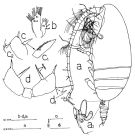 issued from : A.F. Campaner in Bolm. Zool., Univ. S. Paulo, 1984, 6 . [p.183, Fig.9]. Female (off Rio de Janeiro: b, d; Pacific specimen: a, c): a, habitus (lateral left side); a1, genital complex (enlarged); b, Mx1 (Ba2 = basipodal segment 2; Ri = endopodite; Re = exopodite); c, P5; d, P5
|
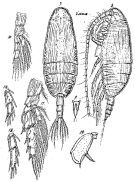 Issued from : G.O. Sars in Résult. Camp. Scient. Prince Albert I, 69, pls.1-127 (1924). [Pl.LII, figs.7-14]. As Scolecithrix abyssalis. Female (from W Mediterranean Sea): 7, habitus (dorsal); 8, idem (lateral left side); 9, rostrum; 10, P1; 11, P2; 12, endopodal segments of P3; 13, endopodal segments of P4; 14, P5. Nota Female: - Rostrum prominent, strongly splitted into 2 narrow points, each bearing a thick and long filament. - Posterolateral corners of the last thoracic segment regularly rounded. - Urosome longer than 1/4 length of prosome. - A1 reaching the end of the caudal rami. - P2 with the spine of the 1st exopodal segment strongly curved inward. - P5 oval lamella-shape, 1 strong spine on the inner margin, 1 little spine at apex, 1 tiny tooth on the external margin.
|
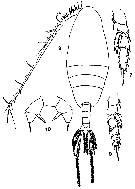 issued from : T. Mori in The pelagic Copepoda from the neighbouring waters of Japan, 1937 (2nd edit., 1964). [Pl.26, Figs.7-10]. Female (E coast of Taiwan): 7, P3 (posterior); 8, habitus (dorsal); 9, P2 (posterior); 10, P5. Nota Female: - Thoracic segments 4 and 5 completely fused. Posterolateral corners of the last thoracic segment rounded. - A1 22-segmented, extend about the caudal rami. - P2 with marginal spine on the 2nd exopodal segment curved. - P5 symmetrical; 1-segmented, its terminal portion somewhat triangulated; there are 3 spines: the outer marginal spine very short, yje inner marginal spine stout and much longer than the terminal one.
|
 issued from : T. Mori in The pelagic Copepoda from the neighbouring waters of Japan, 1937 (2nd edit., 1964). [Pl.25, Fig.13]. Female: 13, P4.
|
 issue from : J.M. Bradford in N. Z. Jl mar. freshw. Res., 1970, 4 (4). [p.355, Figs.26-29]. Male (from Kaikoura): 26, P2; 27, P3; 28, terminal exopod segment of left P5; 29, P5; Scale bars: 0.01 mm (28); 0.1 mm (others)
|
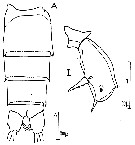 issued from : C. Razouls in Th. Doc. Etat Fac. Sc. Paris VI, 1972, Annexe. [Fig.45, A, I]. Female (from Banyuls, G. of Lion): A, urosome (dorsal); I, P5.
|
 Issued from : W. Giesbrecht in Systematik und Faunistik der Pelagischen Copepoden des Golfes von Neapel und der angrenzenden Meeres-Abschnitte. - Fauna Flora Golf. Neapel, 1892. Atlas von 54 Tafeln. [Taf. 37, Fig. 7 ]. As Scolecithrix abyssalis. Female: 7, habitus (lateral).
|
 Issued from : W. Giesbrecht in Systematik und Faunistik der Pelagischen Copepoden des Golfes von Neapel und der angrenzenden Meeres-Abschnitte. - Fauna Flora Golf. Neapel, 1892. Atlas von 54 Tafeln. [Taf. 13, Fig. 15]. As Scolecithrix abyssalis. Female: 15, P2 (posterior view). B = basipod; St = terminal seta.
|
 Issued from : W. Giesbrecht in Systematik und Faunistik der Pelagischen Copepoden des Golfes von Neapel und der angrenzenden Meeres-Abschnitte. - Fauna Flora Golf. Neapel, 1892. Atlas von 54 Tafeln. [Taf. 13, Fig. 40]. As Scolecithrix abyssalis. Female: P5.
|
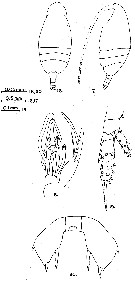 issued from : G.D. Grice in Fish. Bull. Fish and Wildl. Ser., 1962, 61. [p.207, Pl.16, Figs.16-20]. Female (from equatorial Pacific): 16-17, habitus (dorsal and lateral, respectively); 18, terminal part of Mx2; 19, P2; 20, P5. Nota: Some variation was noted in the structure of P5; several specimens did not have the small spine-like protrusion near the terminal spine (fig.20).
|
 Issued from : W. Giesbrecht in Systematik und Faunistik der Pelagischen Copepoden des Golfes von Neapel und der angrenzenden Meeres-Abschnitte. - Fauna Flora Golf. Neapel, 1892. Atlas von 54 Tafeln. [Taf. 13, Fig. 40]. As Scolecithrix abyssalis. Female: 40, P5.
|
 Issued from : W. Giesbrecht in Systematik und Faunistik der Pelagischen Copepoden des Golfes von Neapel und der angrenzenden Meeres-Abschnitte. - Fauna Flora Golf. Neapel, 1892. Atlas von 54 Tafeln. [Taf. 13, Fig. 29]. As Scolecithrix dubia. Male: 29, P5 (anterior view).
|
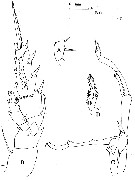 Issued from : J.M. Bradford, L. Haakonssen & J.B. Jillett inNew Zealand Oceanogr. Inst. Memoir 90, 1983. [p.105, Fig.62, A-D]. Female (from off W New Zealand): A; P5. Male (from off NW New Zealand): C, P5; D, terminal part of left leg. Nota Female: - Posterolateral corner of last thoracic segment broadly rounded in lateral view. - Genital segment slightly vaulted ventrally. - A1 21-segmented, reaches almost to caudal rami. - External spine of P2 exopodal segment 1 curved inwards. - P5 semi-oval to triangular; internal spine at mid-length of inner border about twice length of terminal spine; small projection on outer border opposite internal spine.
|
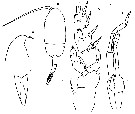 Issued from : O. Tanaka in Japanese J. Zool., 1937, VII, 13. [p.261, Fig.311]. As Scolecithricella dubia. Male (from coast of Heda, Japan): a, habitus (dorsal); b, forehead (lateral); c, rostrum; d, P2; e, P5. Nota Male: - Combined length of the urosome contained 2.6 times in the length of the cephalothorax. - Right A1 19-segmented; segments 8-12, 20-21 and 24-25 fused. Left A1 20-segmented; segments 20 and 21 separated. They reach about to the end of the genital segment. - P5 closely agree with the figure given by Giesbrecht (1892, Taf.13, fig.29). Tanaka (1962) gives for a male from Suruga Bay: Abdomen contained 2.25 times in the length of the cephalothorax. - Abdominal segments and caudal rami in the proportional lengths 15 : 29 : 21 : 21 : 4 : 10 = 100. - A1 extends to the middle of the 2nd abdominal segment - A2 with the exopod 1.4 times as long as endopod.
| | | | | Compl. Ref.: | | | Massuti Alzamora, 1942 (p.111); Sewell, 1948 (p.349, 502, 508, 516, 546, 557, 566); Ahlstrom & Thrailkill, 1963 (p.57, Table 5, abundance); Shmeleva, 1964 a (p.1068); Unterüberbacher, 1964 (p.25); Grice & Hulsemann, 1965 (p.224); Mazza, 1966 (p.70); Pavlova, 1966 (p.43); Fleminger, 1967 a (tabl.1); Park, 1970 (p.476); Gamulin, 1971 (p.382, tab.3); Deevey, 1971 (p.224); Björnberg, 1973 (p.332, 389); Vives & al., 1975 (p.43, tab.II, XII); Carter, 1977 (1978) (p.35); Dessier, 1979 (p.205); Pipe & Coombs, 1980 (p.223, figs. 1, 2, table 1, vertical distribution); Vives, 1982 (p.292); Kovalev & Shmeleva, 1982 (p.84); Brenning, 1984 (p.5, Rem.); Guangshan & Honglin, 1984 (p.118, tab.); Brenning, 1985 a (p.28, Table 2); Longhurst, 1985 (tab.2); Rudyakov, 1986 (tab.2); Brinton & al., 1986 (p.228, Table 1); Chen Y.-Q., 1986 (p.205, Table 1: abundance %, Table 2: vertical distribution); Jimenez-Perez & Lara-Lara, 1988; Lozano Soldevilla & al., 1988 (p.59); Gopalakrishnan & Balachandran, 1992 (p.167, figs.1, 4, Table 1, 2); Shih & Young, 1995 (p.73); Gopalakrishnan & Saraledevi, 1998 (p.130, fig.4, chart); Padmavati & al., 1998 (p.347); Hure & Krsinic, 1998 (p.49, 101); Gilabert & Moreno, 1998 (tab.1, 2); Suarez-Morales & Gasca, 1998 a (p.111); Fernandez-Alamo & al., 2000 (p.1139, Appendix); Madhupratap & al., 2001 (p. 1345, vertical distribution vs. O2, figs.4, 5: clusters); Sameoto & al., 2002 (p.13); Vukanic, 2003 (139, tab.1); Lo & al., 2004 (p.89, tab.1); Lavaniegos & Jiménez-Pérez, 2006 (p.155, tab.2, 3, Rem.); Dur & al., 2007 (p.197, Table IV); Ayon & al., 2008 (p.238, Table 4: Peruvian samples); Lan Y.-C. & al., 2009 (p.1, Table 2, % vs hydrogaphic conditions); Mazzocchi & Di Capua, 2010 (p.427); Tutasi & al., 2011 (p.791, Table 2, abundance distribution vs La Niña event); Andersen N.G. & al., 2011 (p.71, Fig.3: abundance); Hidalgo & al., 2012 (p.134, Table 2) ; in CalCOFI regional list (MDO, Nov. 2013; M. Ohman, comm. pers.), Lidvanov & al., 2013 (p.290, Table 2, % composition); Benedetti & al., 2016 (p.159, Table I, fig.1, functional characters); Belmonte, 2018 (p.273, Table I: Italian zones) | | | | NZ: | 19 | | |
|
Distribution map of Scolecithricella abyssalis by geographical zones
|
| | | | | | | | | | | |  issued from : Gopalakrishnan & Saraledevi in Pelagic Biogeography ICoPB II. Proceedings of the 2nd International Conference. Final report of SCOR/IOC working group 93. Noordwijkerhout, The Netherlands 9-14 July 1995. Workshop Report No.142. UNESCO, 1998. [p.131, Fig.4]. issued from : Gopalakrishnan & Saraledevi in Pelagic Biogeography ICoPB II. Proceedings of the 2nd International Conference. Final report of SCOR/IOC working group 93. Noordwijkerhout, The Netherlands 9-14 July 1995. Workshop Report No.142. UNESCO, 1998. [p.131, Fig.4].
Distribution and abundance in number of specimens/standard haul of Scolecithricella abyssalis in the Indian Ocean. |
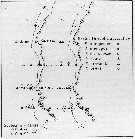 issued from : U. Brenning in Wiss. Z. Wilhelm-Pieck-Univ. Rostock - 33. Jahrgang 1984. Mat.-nat. wiss. Reihe, 6. [p.6, Fig.2]. issued from : U. Brenning in Wiss. Z. Wilhelm-Pieck-Univ. Rostock - 33. Jahrgang 1984. Mat.-nat. wiss. Reihe, 6. [p.6, Fig.2].
Spatial distribution for Scolecithricella abyssalis and other scolecithrids from 8° S - 26° N; 16°- 20° W, for different expeditions (V1: Dec. 1972- Jan. 1973; V2: Feb/Mar. 1973; VI: May 1974; IV: Jun./Jul. 1972). |
| | | | Loc: | | | South Africa (E), Namibia, ? Angola, Congo, G. of Guinea, off SW Ascension Is., Brazil, off Amazon, off Cape Verde Is., Canary Is., off Morocco-Mauritania, off Madeira, Ibero-moroccan Bay, Caribbean Sea, G. of Mexico, Sargasso Sea, off Bermuda, off E Nova Scotia, Medit. (Alboran Sea, Banyuls, NW Basin, Ligurian Sea, Tyrrhenian Sea, Strait of Messina, S Adriatic Sea, Aegean Sea, Lebanon Basin), Arabian Sea, S Madagascar, Natal, SW Indian, Indonesia-Malaysia, Philippines, China Seas (East China Sea, South China Sea), Taiwan Strait, Taiwan, Mienhua Canyon, Japan, Izu region, Bikini, Pacif. (equatorial & NE), Pacif. (W equatorial), New Zealand, California, W BaJa California, Gulf of California, G. of Tehuantepec, off W Guatemala, Galapagos-Ecuador, Peru, Chile (N, off Santiago). Wyville Thomson Ridge (60°N, in Pipe & Coombs, 1980) | | | | N: | 81 | | | | Lg.: | | | (9) F: 2,21-1,74; M: 2,25-1,45; (47) F: 1,9; (101) F: 2,21-1,74; (117) M: 1,45; (128) M: 1,48; (432) F: 2,15-1,7; (1111) F: 1,73-2,06; {F: 1,70-2,21; M: 1,45-2,25} | | | | Rem.: | epi-mesopelagic. 410-580 m (Pipe & Coombs, 1980, Arctic: 60°N).
In remarks from Tanaka (1962, p.45), three species, S. abyssalis, S. dentata, S. profunda resemble each other in the structure of the female P5.
For Campaner (1984 a, p.182) the males described by Rose (1942) and Tanaka (1962) do not belong to this species, but to S. vittata in the first case, and not assigned in the second.
A doubt subsists on the identity between this species and S. profunda (see remarks at this species).
According to Giesbrecht (1892), the two species are distinguishable by small differences in the shape of P5 like in the figures in Park (1980).
For Vervoort (1965) the two species could be synonyms.
The confusion with S. abyssalis is frequent, hence an uncertain geographical distribution. | | | Last update : 18/01/2021 | |
|
|
 Any use of this site for a publication will be mentioned with the following reference : Any use of this site for a publication will be mentioned with the following reference :
Razouls C., Desreumaux N., Kouwenberg J. and de Bovée F., 2005-2025. - Biodiversity of Marine Planktonic Copepods (morphology, geographical distribution and biological data). Sorbonne University, CNRS. Available at http://copepodes.obs-banyuls.fr/en [Accessed November 29, 2025] © copyright 2005-2025 Sorbonne University, CNRS
|
|
 |
 |



















